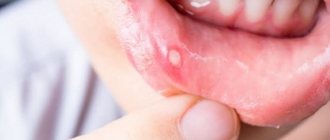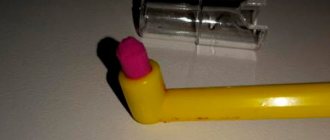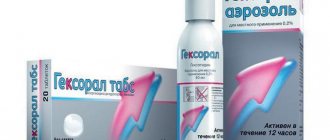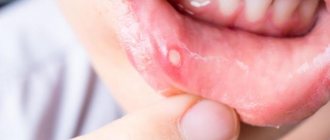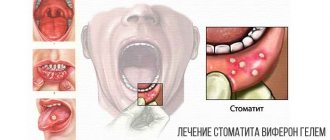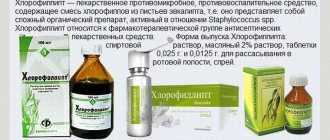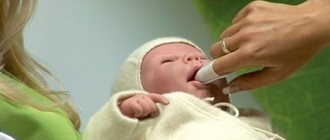Stomatitis is an infectious disease characterized by a rash of multiple ulcers in the oral cavity. The ulcers cause pain while eating and talking. Stomatitis affects people with weakened immune defenses of any age group. Stomatitis is one of the first diseases to appear in newborn infants. Does oxolinic ointment help with stomatitis? Let's consider the methods and features of application.
Description of the drug
Pharmacologists have a large number of drugs in their arsenal to combat stomatitis, each of which has its own active formula. However, it should be kept in mind: the cause of ulceration of the mucous membrane can be of a different nature. There are stomatitis of viral origin, a disease after trauma to the oral cavity, and stomatitis due to a deficiency of vitamins/minerals in the body.
Oxolin belongs to a group of drugs with an active antiviral formula. The ointment prevents the spread of pathogenic microbes/viruses, depriving them of activity and nutrient medium. The fatal effect of the ointment is also aimed at the pathogens of the herpes virus, which causes multiple ulcers on the mucous membranes.
Advantages of oxolinic ointment:
- has a local effect on the site of inflammation;
- has a rapid effect on the mucous membrane;
- has a minimum of contraindications;
- used by adults and children;
- not absorbed into the blood;
- easy to use;
- It's inexpensive.
An active effect of oxolin components on the herpes zoster virus, which belongs to the herpes group, was also noted. It is characteristic that the use of oxolinic ointment as an antiviral agent is justified only on the territory of our state; in Europe, the ointment is not included in the group of antiviral drugs. This is due to the fact that the medicinal formula was discovered by Soviet scientists and did not receive the appropriate certificate of international significance.
Effect of the ointment
Oxolinic ointment for stomatitis is used as prescribed by a doctor. Independent use is unacceptable. To disinfect the oral mucosa for herpetic stomatitis, use 0.25% ointment. A sign of this type of disease is redness of the mucous membrane with multiple rashes of ulcers. The disease is accompanied by hyperthermia and uncontrolled salivation.
Oxolinic ointment for stomatitis in adults and children eliminates not only the symptomatic manifestations of the infection, but also eliminates the cause of the disease. When the drug dries, it forms a protective film that prevents the activity of microbes. Under the film, tissue healing and regeneration occurs.
The product is used for its intended purpose:
- treatment of stomatitis;
- treatment and prevention of ARVI
- viral eye infection.
For preventive purposes, this drug is applied to the nasal mucosa before leaving the house using a cotton swab, as well as in the evening.
How does oxolin work?
Oxolin has antiviral activity. The ointment blocks the further spread of viruses, destroying the environment favorable for them. Under current conditions, pathogenic microflora loses the ability to reproduce and is soon completely destroyed.
The active substance oxolin is active against herpes viruses and adenoviruses.
The advantages of this ointment are as follows:
- acts specifically at the site of the lesion;
- eliminates the cause of infection;
- slight absorption of the active component into the blood;
- the medicine remains for a long time on the surface of the mucous membrane and is not washed off by saliva;
- suitable for use by adults and children;
- has a small number of contraindications and restrictions;
- low price.
Its use reduces the size of ulcers in the mouth and reduces pain. After application, the product dries and forms a protective film layer that serves as a barrier to the spread of microbes. At the same time, under the film layer, the damaged tissues are restored.
Oxolinic ointment for stomatitis: application
How to use oxolinic ointment for stomatitis? Before applying the medicine to the affected areas, hardened crusts should be removed. To do this, you need to moisten a cotton swab in an oily solution of vitamin A and treat the affected areas. A replacement for the oil solution of the vitamin can be sea buckthorn or rosehip oil.
Afterwards, the oral cavity is washed with decoctions of medicinal herbs/plants:
- St. John's wort;
- chamomile;
- calendula;
- nettle.
To treat the oral cavity of children over 2 years old, wipe the mucous membrane with a swab dipped in a decoction of the listed herbs. However, first you need to make sure that the baby does not have an allergic reaction to the active components of the plants: smear a small area of the back of the hand with the decoction. If the skin does not turn red, the plant can be used for treatment.
After thoroughly treating the affected surface, apply ointment using a cotton swab. The product should be applied to the sores themselves 4 times a day. Please note: after applying oxolinic ointment to the affected area, a burning sensation may be felt. This is considered an acceptable phenomenon and should not be alarmed. The child needs to be reassured if he starts crying.
Together with the use of oxolinic ointment for stomatitis in children, comprehensive measures to strengthen immune defense are recommended.
Preparing for treatment of stomatitis
Before applying the ointment, the oral cavity must be prepared.
The preparation stages are as follows:
- It is necessary to get rid of crusts formed on the gums, lips and mucous membranes. To do this, use a cotton swab (it must first be soaked in oil with a high content of vitamin A) or a bandage. Rosehip/sea buckthorn oil will also be effective.
- You will then need to rinse your mouth with a chamomile infusion, although calendula/nettle will also work. Calendula tincture can also replace chamomile infusion.
- Apply a certain amount of antiseptic to avoid possible pain.
- If you need to treat stomatitis in a child’s mouth, this may pose some difficulties, especially if they are very young. In this situation, you can wipe your mouth with a swab soaked in the broth or with a regular bandage.
Types of stomatitis
The disease is characterized by ulceration of the oral mucosa; however, stomatitis is caused by different viruses. There are several types of disease:
- herpes;
- candida;
- aphthous;
- allergic.
The most common type of stomatitis is considered to be aphthous: it occurs due to poor-quality sanitation of the oral cavity or injury to the mucous membrane. Candidal stomatitis most often affects the mucous membranes of children, while herpes stomatitis is of viral origin.
If the disease is fungal in nature, antifungal drugs should be used; for aphthous stomatitis, antibacterial agents are used; for viral stomatitis, oxolin is used. If the nature of stomatitis is allergic in nature, ointments/gels with antifungal/antiviral agents will not help!
It is important to understand: each type of stomatitis is treated according to a specific scheme. Therefore, independent use of medications is unacceptable. Oxolinic ointment helps only with the viral nature of ailments, in particular, ulceration of the oral mucosa.
The cause of stomatitis can be an incorrect bite, bad habits in a child, or a lack of minerals in the body. Therefore, it makes no sense to use oxolin in this case. Before starting treatment, consult your dentist.
How to determine viral stomatitis in a child
It should be noted that viral stomatitis belongs to the group of contagious diseases and is easily transmitted to a healthy child from a patient. A favorable factor for the development of the virus is the imperfection of the baby’s immune system and poor-quality sanitation of the oral cavity.
In children, viral stomatitis can also appear against the background of eating hot/chilled food: microbes actively penetrate into microcracks in the mucous membrane. Viral activity can be triggered by disruption of the baby’s daily routine, changing seasons, and nervous tension. Any attack on an imperfect immune system can cause a malfunction in the small organism.
Signs of the development of the disease in a child are:
- increased excitability, tearfulness;
- redness and swelling of the oral mucosa;
- refusal to eat, crying when chewing food;
- the appearance of bad breath;
- troubled night's sleep;
- temperature increase.
It is important not to confuse the symptoms of stomatitis with the onset of a flu or cold: the baby behaves exactly the same. However, with a cold, the baby looks tired and lethargic, and the flu is accompanied by a high fever. With stomatitis, the child's behavior is different. Parents should examine the baby's oral cavity to understand the cause of the disease.
Contraindications and possible complications
Contraindications and restrictions for the use of ointment based on oxolin include:
- hypersensitivity to the ingredients of the drug;
- pregnancy period (it is possible to use 0.25% ointment in case of urgent need);
- lactation period (permissible to use only under the supervision of a doctor);
- children under 2 years old.
As a side effect of the medicine, there is a burning sensation at the application site, which goes away after 5 minutes. If after the specified time the discomfort does not disappear, then it is necessary to remove the product from the application area and consult a doctor. Patients with diagnosed chronic pathologies should notify their physician before starting treatment with oxoline.
Currently, no cases of incompatibility have been identified when combining oxolinic ointment with other pharmaceuticals.
READ Why does stomatitis occur in the throat and how to treat it?
How to replace the drug
What ointments/gels are used for stomatitis? The pharmaceutical industry offers the following drugs:
- acyclovir;
- nystatin;
- methyluracil;
- Cholisal;
- solcoseryl;
- Metrogil denta.
Acyclovir suppresses the activity of the herpes virus and has a similar effect to oxolinic ointment. Nystatin is used for the fungal form of the disease - candidiasis. Methyluracil (and Solcoseryl) is used for the bacterial form of the disease (aphthous type).
Cholisal is a universal gel for all forms of illness. This drug can also be used in infants up to one year old. The disadvantage of the drug is its high price. Metrogyl Denta contains an antibiotic, so self-prescription of the drug is unacceptable. This product is approved for use by children over six years of age.
What can it be replaced with?
Oxolin is not the only drug that can fight viral stomatitis. In case of individual intolerance to the drug, analogues can be easily found on the pharmaceutical market.
The drug Acyclovir has a similar effect to oxolin; aphthous forms of stomatitis can be successfully treated with Solcoseryl.
Cholisal is considered a universal drug, which is used to treat stomatitis of any origin. The advantage of this medicine compared to oxolin is that it can be used for therapy even in infants under 1 year of age.
Another product that deserves attention is Metrogyl Denta. The drug contains an antibiotic, so only a doctor should prescribe the gel. For the same reason, this drug is contraindicated in children under 6 years of age.
Compared to all medications intended to get rid of stomatitis, oxolinic ointment is characterized by its low cost. For a tube of 0.25% ointment weighing 25 g, on average you need to pay 45 rubles (depending on the region).
The cost of similar products is slightly higher:
- Cholisal gel – from 170 rubles;
- Metrogil Denta - from 195 rubles;
- Solcoseryl - from 300 rubles.
It is recommended to buy medications online, on official pharmacy websites. There you can immediately find out how much this or that medicine costs, and as a rule, the prices there are much lower.
Bottom line
Oxolinic ointment defeats stomatitis of viral origin. The use of medicine against a disease caused by other reasons is not effective. Before buying an inexpensive drug at the pharmacy, you should find out the nature of the disease: for what reason did ulcers appear on the cheeks, lips and tongue? If the ulceration is viral in nature, the doctor will prescribe treatment with oxoline.
Oxolinic ointment for stomatitis in a child is indicated after the age of two. In some cases, a pediatrician/dentist may prescribe treatment with oxoline before reaching this age, however, it is not advisable to make a decision on your own. To suppress viruses in infants, there is another medicine - Cholisal.
To prevent stomatitis from affecting the oral cavity, you should strengthen your immune defense, thoroughly sanitize your oral cavity, eat rationally, avoid biting your nails, and wash off dirt from your hands before eating.
Sources used:
- Medicines in dentistry. Directory / L.N. Maksimovskaya, P.I. Roshchina. - M.: Medicine, 2001.
- Mashkovsky M.D. Medicines. — 15th ed. - M.: New Wave, 2005.
- Oxoline(English). MeSH Supplementary Concept Data. US National Library of Medicine (07/14/2000). — “Substance oxoline .. tetraoxotetrahydronaphthalene dihydrate”
Composition and properties
This product contains the active substance oxolin. It forces the body to produce interferon reducers, which, in turn, resists the disease. However, according to some scientists, this effect of oxolin leads to depletion of the body and weakened immunity. Therefore, drugs containing it are prohibited in many countries around the world. Its action is similar to that of an antibiotic and is also addictive.


